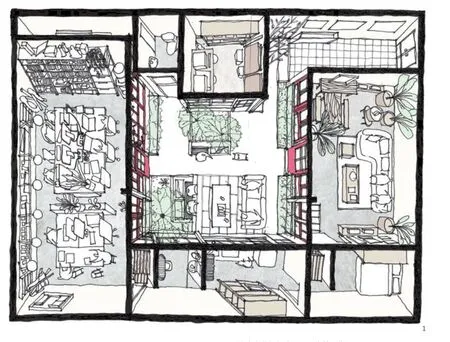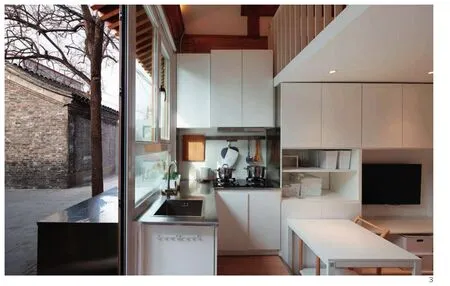和马町访谈
2019-08-07天妮TIANNi
天妮/TIAN Ni
齐轶昳 译/Translated by QI Yiyi
WA:能否分享一下您对北京历史街区的整体印象?
和马町:自从2010年从荷兰搬到北京以来,我对这个城市中3种不同城市类型共存这一点感触很深:第一种是历史悠久的皇城,以胡同巷道和封闭式的院子为代表;第二种是以单位大院为代表的规划体系;第三种是以超级街区和孤立塔楼为特征的现代化城市。这3种类型的街区我都住过,大约6年前最终选择定居在北京的历史街区。对我来说,这里是我感觉最适合本地生活方式和气候的类型,拥有强烈的地方感和良好的社会凝聚力。 最开始,我在西城区的西海住了几年,在一个共用的院子里。但3年前我们搬到了东城区北新桥附近的一个私人院子里。
作为一名实践建筑师,我认为在为自己创造空间的时候应该像为其他人创造一样,试图将理论思想与当下现实生活条件相结合。因此选择在这种类型的空间中生活和工作反应和体现出我们的理念。这个院子很有历史,在著名的乾隆北京历史巷道地图上都有所显示。在这个基础上,我们创造了一个现代化的生活和工作空间,但没有改变历史悠久的庭院结构(图1)。我们的庭院位于一个拥有3000多万人口的大都市的中心,可以看作是现代同质化都市中的绿洲。我们在这次实践中试图做的可以被定义为“反思性的区域主义”,它更多的是识别原始条件而不是创造新形式或物件;它是关于技术、社区、当地材料、现代思维和传统认同感的结合。在现代都市混乱嘈杂的背景下,它可以被看做是一小片自然、和谐与宁静的存在。
不幸的是,在中国当代的城市发展中,这种观念似乎已经消失了。经过几轮土地改革和快速的城市化,以前和谐的体系如今却是一幅不和谐的景象,城市基础设施和补丁一样的城市肌理相混杂。如当前在历史悠久的北京市中心所见,“传统的”胡同充满了违章建设,且伴随着过度拥挤、基础设施和卫生条件差等问题。
WA:白塔寺地区的哪些品质吸引了您的注意?在您看来,与其他古老的历史街区(如什刹海等)相比,白塔寺的特质是什么?
和马町:上述提到的北京各种城市类型并置的情况统统体现在了白塔寺这一个城市街区内,这使得城市环境变得充满活力。你可以在这个街区里通过一个仅仅10min步行的路程大致感受到北京的历史。从古老的被烧毁的寺庙(它带给街道一些非典型的道路网格)到白塔寺,再到鲁迅博物馆或者福绥境社会主义大楼生活区,在走过这些地方的同时却不用经过街区周边的主干道。 白塔寺地区也相当独立,例如,它不依赖于外部旅游业。这个街区外部边缘承担着与周围更大范围城市结构连接的作用,并在该区域的内部保留下了一块非常本地化的区域。
WA:如何通过微更新的设计方法改善胡同住宅区的环境质量?长期和短期分别用什么方法?
和马町:我认为不太可能概括地说一个微更新设计方法本身是否成功或如何成功。我认为胡同住宅区重建或“设计更新”没有标准的解决方案。每个北京胡同地区都有着截然不同的特点,其常住人口结构和当地经济等都有差异。正确的方法应该是从一个通用的自上而下的模式转变为自下而上的综合方式。规划者在这个过程中只是一个促进者的角色,但关键因素还是取决于当地特色、面临的挑战和当地居民的想法。此过程也不应该立即产生一个不变的最终结果,而应随着时间产生动态的空间博弈。因此,不是仅仅强调最终的结果(例如为生活创造一个空间),应该非常强调包含各个利益方的参与式设计过程。我们可以将此定义为从公共空间到市民空间的转变。在这个空间中,我们和他们之间不再是简单黑白对立的存在,而是强调集体公民的责任。

1 受访者在北新桥生活和工作的工作室/ Author's live &work courtyard studio in Beixinqiao(绘图:吕蕙欣/Drawing by Huixin Loo)
关于最近的胡同住宅再开发,我们可以看到天安门广场东南方的前门地区改造就是一个很好的例子,解释了为什么不使用一般的自上而下的手法。几个世纪以来,前门一直是一个非常公共、热闹的地区,就在内城城墙外,但仍然在皇城里。然而,重建计划是一个自上而下实施的标准方案,纯粹是资本驱动、内部决策和权威性的,没有考虑“通过时间进行空间谈判”的方法,也没有考虑任何“共同设计”的方法。这样的结果是形成了一层像是贴在混凝土外的历史化表皮,功能上用作商业设施。根据当时知名国有报纸对此的报道是“外观大幅改善”,但仅仅是表面的价值。但遗憾的是,这样的方式进行改造没有任何传统价值和持久的功效。在闪闪发光的外立面背后,有价值的内容很少。于是,这个区域在城市的中心变成了一个尴尬的存在,因为正好处在皇城根脚下。在接下来的大栅栏开发中(就在前门地区附近),这种自上而下的、展示/重建类型的历史街区重建方式被强制执行。相反,这次改建邀请当地社区参与进来,并制定了一个精心策划的空间模式——即所有被收购的破旧(公共)房屋无论其条件如何都保持不变,并将它们租给精心挑选的新业主。这些业主符合该地区的需求和前景,并且愿意融入胡同生活。

2 白塔寺改造前居住环境/Baitasi local resident conditions before renovation
WA: Can you please share some overall impression of Beijing's historical areas?
Martijn de Geus: Ever since moving to Beijing from Holland in 2010, I have been impressed by the juxtaposition of three distinct urban typologies coexisting within the city; the historic Imperial City with its hutong laneways and enclosed courtyards yuanzi, the planned system with its danwei (Unit)in their "dayuan" (Compound), and the modern city with its superblocks and isolated towers. I've lived in all three typologies; but finally settled in Beijing's historical area about 6 years ago. To me it feels to be the typology most fit for the local lifestyle and climate, with a strong sense of locality and good social cohesion. First, I lived several years around the West Lake in the Xicheng district in a shared yard, but three years ago we moved to a private yard around Beixinqiao in Dongcheng district.
As a practicing architect I believe that you should create a space for yourself as you would want to create for other, to try to integrate theoretical ideas with contemporary real-life conditions, and so the choice to live and work in this type of space is an embodiment of what we stand for. Within the original yard, that can already be seen drawn on the famous Qianlong map of Beijing's historic laneways,we have created a modern living and working space without altering the historic courtyard structure (Fig.1). Situated at the centre of a sprawling metropolis of over more than 30 million people, our courtyard is an oasis from modern urban homogeneity. What we are trying to do in this practice might be described as a re flexive regionalism; it is more about identifying original conditions than inventing original forms or objects. It is about combining technology,community, local materials, modern thinking and a traditional sense of identity. A little piece of nature,harmony and tranquillity against the backdrop of modern urban chaos.
Unfortunately, in recent and contemporary urban development in China, this conception seems to have been lost. Following several rounds of landreforms and rapid urbanization, the previously harmonious system is now more of a giant cacophony of urban infrastructure and patch work structures,as seen in the state of the current historic city centre of Beijing, where "traditional" hutong alley ways are crammed with illegal buildups, overcrowded living conditions, bad infrastructure and poor hygiene.
WA: What kind of qualities of the Baitasi area attracts your attention? In your opinion, compared with other old historical districts (such as Schichahai, etc), what are the unique identity characteristics of Baitasi?
Martijn de Geus: The aformenetioned juxtaposition of various urban typologies in Beijing happens all within one city-scale block in the Baitasi area,which makes for a dynamic urban environment.You can read the history of Beijing at large within a 10-minute walk through just this area. From the ancient burned down temple that left some atypical road network to the laneways, the White Pagoda,the LuXun Museum or the Fusuiqing communist living quarters that towers above it all, while at the same time not even being visible from the main streets surrounding the area. The Baitasi area is also rather independent, it does not rely heavily on outside tourism for its economy for instance. The outer block edges provide a connection with the surrounding larger urban fabric, and leaves a very localised realm on the inside of the area.
WA: How to improve the environmental quality of Hutong's residential area by micro update design approach? How about long-term and short-term?
Martijn de Geus: It is impossible to say if or how a generalized micro update design approach in itself will be successful. And that should be the approach:there is no standard solution to a hutong residential area redevelopment or "design update". Each Beijing hutong area has very different characteristics, with a very different build-up of its resident population, local economy, etc. The right approach should be to change from a one-size- fits-all top-down implementation to a more bottom up, integrated model, in which planners facilitate a process in which local characteristics, local challenges and residents are key. This process should also not have a static outcome that produces an immediate fixed result, but instead should be based on a model of spatial negotiation through time. Thus,rather than (only) de fining the intended outcome, e.g.to produce space for living, there should be a strong emphasis on the participatory design process with various parties involved. We could define this as a move from public to civic space, in which there is no longer a black/white division of tasks between us and them, but instead an emphasis on the collective civic responsibility.
Considering recent hutong residential redevelopment, we can see that the Qianmen-model,an area southeast of Tian'an'men square is a good example of why not to use a general top-down model anymore. For centuries long Qianmen was a very public, lively area just outside the inner-city wall,but still within the lmperial City. The redevelopment plan however was a top-down implemented standard solution, purely capital driven, privatized and full of prestige, without consideration of the"spatial negotiation through time" nor any "codesign methodologies".The result was a historic wallpaper facade over a cleaned up series of concrete supposed-to-be shopping facilities. According to leading state-owned newspapers of the time a"substantial improvement in appearance" , at face value. But, unfortunately not lasting and void of any local signi ficance. Behind the glittery façade makeover there was little substance left. And the area turned out to be a painful embarrassment, right in the centre of the city, under the eyes of the emperor.In the sub sequential Dashilar development, just adjacent to the Qianmen area, a stop on this top down, demo/rebuild type of historic redevelopment was enforced. Instead the local community was involved, and a curated spatial approach was developed, in which all the acquired dilapidated(public) houses remained untouched regardless their conditions, and were rented to carefully selected new owners, who fit the needs and prospects of the area and were willing to blend into hutong life.
在大栅栏的实践模式获得认可并成功融入北京国际设计周及其他试点项目之后,该模式被进一步应用于北京城区更为中心和敏感的地区,如白塔寺。从大栅栏的经验中学习,这一次建立了一个综合的框架,开发人员和总体规划师与当地政府、居民、建筑师、学者和学生合作,被称为“白塔寺再生计划”。与大栅栏项目的一个重大区别是,白塔寺地区的主要目标不仅仅是引入新角色并随之高档化,而是一个社会过程,其中当地居民和基础设施要在新的外部利益相关者被引入之前得到改善。在我看来,白塔寺项目旨在采取调查性的、参与式的方法,与当地居民合作,评估转型过程及其对个人、机构、企业和高层次框架下包含政府共同参与的利益相关者的影响。
WA:北京国际设计周和白塔寺地区之间都有哪些双向影响?
和马町:首先,整个地区的改造通过该地区作为北京设计周的重要区域,向当地居民以外的公众进行了良好的传达。而这反过来可以激发其他自发的自下而上的行动,类似于大栅栏的发展过程。各种例子已经有不少,比如当地的一些咖啡馆和创意工作室将工作场所转移到那里;还有一本叫《LAWAAI》的小杂志,致力于展示白塔寺当地文化的多样性等等。其次,多方(学术界、市场、居民和政府)参与加快方便了实施的进程,意味着很多研究几乎可以实时进行。例如,《世界建筑》杂志作为参与的一方可以协助举办一系列公共论坛和青年设计师竞赛,以便从外部引入新的想法。还有很明智的一点是,在建筑和社会层面,有两个值得一提的试点项目。这些试点项目在过去的北京国际设计周中已被作为实施策略综合研究的例子实现和展示。第一个是一个试点民居改造,由来自清华大学的张悦教授领导的设计团队完成。它旨在通过与当地原住居民的密切合作来促进留住当地居民的改造模式。
首先一些违建的部分被拆除,然后在里面创建了一个紧凑的多功能储藏解决方案。另外还增加了一个阁楼层,并在院子里安装了预制马桶。 最终打造出两个家庭单元和一个中央“共享室”,可用于接待客人或休闲活动。为了评估设计意图的实用性和有效性,其中一个单元目前由开发人员的项目经理使用。另一个居住单元以两周为轮换周期被提供给该地区的家庭自愿使用。他们可以通过试住来决定是否愿意在自己的家中采用此种方法改造。此外,对于入住后的更多使用情景评估还有待深入研究。

3 改造的“样板房屋”,有橱柜配套和储藏、阁楼解决方案/The renovated "model house", with kitchen arrangement and storage/Loft solution(图片来源:张悦/Courtesy of ZHANG Yue)

4 由清华学生构设计构思的白塔寺“共享院”/The Baitasi"Sharing Courtyard", conceived by students from Tsinghua University(图片来源:受访者/Courtesy of the author)
第二个案例侧重于改善公共环境,是清华大学国际硕士课程为期8周的城市设计项目的成果。学生们对地段进行了调查和分析,包括对当地居民的采访。同样,作为直接测试研究成果的一部分,当地政府分配了一个破旧的庭院用来改造,以检测学生们的想法。设计的灵感来自于试图为传统的胡同体验带来全新的视角,让人们可以从3个层面探索和利用庭院,包括一个安静的角落、一个天桥和小型圆形剧场。这些新的改造旨在作为附近环境的一个实用的补充设施,而不是一个抽象的独立存在。新的结构与经过翻新的四合院建立了非常直接的联系,并打开了前所未有的视角。

5 由清华学生构设计构思的白塔寺“共享院”/The Baitasi"Sharing Courtyard", conceived by students from Tsinghua University(图片来源:受访者/Courtesy of the author)
After the successful trial and assessment of the Dashilar efforts, including its integration in the Beijing Design Week and its pilot-projects, this model was also applied in the more central and sensitive Beijing city districts like Baitasi. Learning from Dashilar, this time a comprehensive formal framework was set up where a developer, and master planner, work together with the local governments, residents, architects, academics and students, "Baitasi Remade". A big difference with the Dashilar project, is that the main objective for the Baitasi area is not a mere gentrification with new actors, but foremost a social process in which local residents and facilities are intended to be improved first, before new,outside stakeholders are being brought in. The Baitasi Remade project in my understanding aims to take an investigative, participatory approach, working with local residents to assess processes of transformation and the effect they have on individuals', institutions', corporate and governmental co-participation larger framework of stakeholders.
WA: What are the two-way influence between BJDW and Baitasi?
Martijn de Geus: First of all the transformation of the entire area is well communicated to the general public, outside of the local residents, through the area being one of the key areas for the Beijing Design Week. And this in turn can spark other self initiated bottom-up initiatives, similar to the Dashilar process. Various examples already exist; local cafes,creative studios moving their offices there, a small magazineLAWAAI, dedicated to showing the diversity of Baitasi local culture, etc. Secondly, the combination of various academic, market-driven,residential and government parties means a broad process can be facilitated, in which research can be implemented almost real-time. As suchWAfor instance facilitated a series of public forums and competitions for young architects to bring in fresh ideas from outside. Project wise, on an architectural,social level, there are two realized pilots worth mentioning that were realized and showcased in past BJDW's, as examples of the integrated research to implementation strategy. The first one is a model house, by a design team lead by Prof. ZHANG Yue from Tsinghua Unviersity, aiming to facilitate the retention of local people in close collaboration with the original residents of the plot.
First a series of illegal additions were removed,instead a compact, multifunctional storage solution was created inside, a second loft- floor added, and a prefab toilet united located in the yard. The result is two family units and one central "shared room", that can be used to receive guests or for leisure activities.To assess the practicality and effectiveness of the design intent, one of the units is currently occupied by the project-manager from the developer. The other unit is occupied on a two-week rotational base for families in the area that like to try and see if they would like to have help to adopt this approach in their own homes, a post-occupancy evaluation of a broader scenario that is still to come.
The second example focuses on the improvement of the public environment, and is the result of an 8-week long urban design studio part of the international Master's Program at Tsinghua University, in which students surveyed and analysed the local area, including interviews with local residents.Again, as part of directly testing the research, the local government allocated a dilapidated courtyard for to regenerate, as a test case for the student's ideas. The design was inspired by the opportunity to bring a new perspective to the traditional hutong experience and allow people to explore and utilise the courtyard in three dimensions, including quiet corners, a skywalk and small amphitheatre, and was implemented as a usable addition to the neighbourhood, not as an abstract stand-alone installation. The new structure creates a very direct connection with the renovated courtyard house, and opens up never-before seen perspectives.
注释/Note
1) CHINA DAILY, Qianmen before and after its renovation, 2011. [2018-06-15]. http://www.chinadaily.com.cn/regional/2011-05/13/content_12508907.htm.
